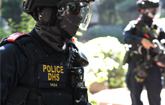WASHINGTON, Sept. 25, 2013 /PRNewswire-USNewswire/ -- NASA and the U.S. Department of Homeland Security are collaborating on a first-of-its-kind portable radar device to detect the heartbeats and breathing patterns of victims trapped in large piles of rubble resulting from a disaster.
(Logo: http://photos.prnewswire.com/prnh/20081007/38461LOGO)
The prototype technology, called Finding Individuals for Disaster and Emergency Response (FINDER) can locate individuals buried as deep as 30 feet (about 9 meters) in crushed materials, hidden behind 20 feet (about 6 meters) of solid concrete, and from a distance of 100 feet (about 30 meters) in open spaces.
Developed in conjunction with Homeland Security's Science and Technology Directorate, FINDER is based on remote-sensing radar technology developed by NASA's Jet Propulsion Laboratory (JPL) in Pasadena, Calif., to monitor the location of spacecraft JPL manages for NASA's Science Mission Directorate in Washington.
"FINDER is bringing NASA technology that explores other planets to the effort to save lives on ours," said Mason Peck, chief technologist for NASA, and principal advisor on technology policy and programs. "This is a prime example of intergovernmental collaboration and expertise that has a direct benefit to the American taxpayer."
The technology was demonstrated to the media Wednesday at the DHS's Virginia Task Force 1 Training Facility in Lorton, Va. Media participated in demonstrations that featured the device locating volunteers hiding under heaps of debris. FINDER also will be tested further by the Federal Emergency Management Agency this year and next.
"The ultimate goal of FINDER is to help emergency responders efficiently rescue victims of disasters," said John Price, program manager for the First Responders Group in Homeland Security's Science and Technology Directorate in Washington. "The technology has the potential to quickly identify the presence of living victims, allowing rescue workers to more precisely deploy their limited resources."
The technology works by beaming microwave radar signals into the piles of debris and analyzing the patterns of signals that bounce back. NASA's Deep Space Network regularly uses similar radar technology to locate spacecraft. A light wave is sent to a spacecraft, and the time it takes for the signal to get back reveals how far away the spacecraft is. This technique is used for science research, too. For example, the Deep Space Network monitors the location of the Cassini mission's orbit around Saturn to learn about the ringed planet's internal structure.
"Detecting small motions from the victim's heartbeat and breathing from a distance uses the same kind of signal processing as detecting the small changes in motion of spacecraft like Cassini as it orbits Saturn," said James Lux, task manager for FINDER at JPL.
In disaster scenarios, the use of radar signals can be particularly complex. Earthquakes and tornadoes produce twisted and shattered wreckage, such that any radar signals bouncing back from these piles are tangled and hard to decipher. JPL's expertise in data processing helped with this challenge. Advanced algorithms isolate the tiny signals from a person's moving chest by filtering out other signals, such as those from moving trees and animals.
Similar technology has potential applications in NASA's future human missions to space habitats. The astronauts' vital signs could be monitored without the need for wires.
The Deep Space Network, managed by JPL, is an international network of antennas that supports interplanetary spacecraft missions and radio and radar astronomy observations for the exploration of the solar system and the universe. The network also supports selected Earth-orbiting missions.
For more information about NASA programs, visit:
SOURCE NASA
WANT YOUR COMPANY'S NEWS FEATURED ON PRNEWSWIRE.COM?
Newsrooms &
Influencers
Digital Media
Outlets
Journalists
Opted In





Share this article